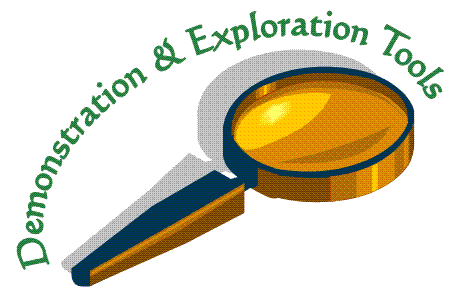| Most of the Internet resources for these early grades are found under Math Games at the right. |
Page Contents:
|
 |
| Broad Expectation* | Topic | Link to Applet and Description |
How good for teacher demos (1-3)? |
How easy for students (1-3)? |
How good for exploration (1-3)? |
Available activities |
| Understand numbers, ways of representing numbers, relationships among numbers, and number systems | ||||||
| Understand meanings of operations and how they relate to one another | Operations (e.g. +) | Pan Balance - Numbers or numeric expressions (e.g., 2+3 or 5-1) can be put on each side of the pan balance. | 3 |
2 |
3 |
|
| Addition | Adding
with Base Ten Blocks - Use base ten blocks to represent
addition. Use the "selection marquee" (drag a rectangle)
to group up blocks. Base Blocks - base ten block introduction. |
3
|
2
|
3
|
||
| Compute fluently and make reasonable estimate | ||||||
| Broad Expectation* | Topic | Link to Applet and Description
|
How good for teacher demos
(1-3)?
|
How easy for students (1-3)?
|
How good for exploration
(1-3)?
|
Available activities
|
| Understand patterns, relations, and functions | ||||||
| Represent and analyze mathematical situations and structures using algebraic symbols | ||||||
| Use mathematical models to represent and understand quantitative relationships | ||||||
| Analyze change in various contexts | ||||||
| Broad Expectation* | Topic | Link to Applet and Description
|
How good for teacher demos
(1-3)?
|
How easy for students (1-3)?
|
How good for exploration
(1-3)?
|
Available activities
|
| Analyze characteristics and properties of two- and three-dimensional geometric shapes and develop mathematical arguments about geometric relationships | ||||||
| Specify locations and describe spatial relationships using coordinate geometry and other representational systems | ||||||
| Apply transformations and use symmetry to analyze mathematical situations | Patterns & Shapes | Pattern Blocks - Same as the physical blocks, just virtual. Nice tool. Another option. | 3 |
3 |
3 |
|
| Use visualization, spatial reasoning, and geometric modeling to solve problems | ||||||
| Broad Expectation* | Topic | Link to Applet and Description
|
How good for teacher demos
(1-3)?
|
How easy for students (1-3)?
|
How good for exploration
(1-3)?
|
Available activities
|
| Understand measurable attributes of objects and the units, systems, and processes of measurement | ||||||
| Apply appropriate techniques, tools, and formulas to determine measurements | Time | Judy Clock - Interactive clock. Click the circles in the upper left and right to show the time written out and digitally. | 3 |
3 |
3 |
|
| Broad Expectation* | Topic | Link to Applet and Description
|
How good for teacher demos
(1-3)?
|
How easy for students (1-3)?
|
How good for exploration
(1-3)?
|
Available activities
|
| Formulate questions that can be addressed with data and collect, organize, and display relevant data to answer them | ||||||
| Select and use appropriate statistical methods to analyze data | ||||||
| Develop and evaluate inferences and predictions that are based on data | ||||||
| Understand and apply basic concepts of probability | ||||||
Click here for the Index for >> Online Math Games, Demonstration/Exploration Tools, and Puzzles
(This page is organized using the five content areas in school mathematics, as articulated in the NCTM Principles and Standards, 2000.)
3=Excellent for class demonstrations of mathematics
2=Fair to Good for class demonstrations of mathematics
1=Not designed for class demonstrations of mathematics
3 = No advance instruction needed (very easy to use).
2 = Short demonstration helpful (pretty easy to use).
1 = Extensive demonstration needed (hard to use without an explanation).
3=Excellent for student exploration of mathematics.
2=Fair to Good for student exploration of mathematics.
1=Not designed for student exploration of mathematics.
by: James
R. Olsen, Western Illinois University
updated:
May 24, 2012